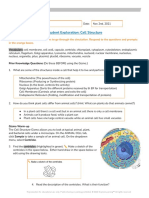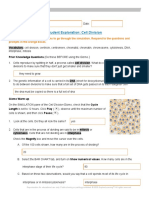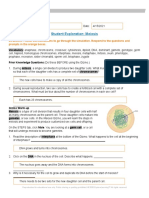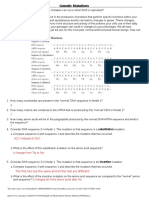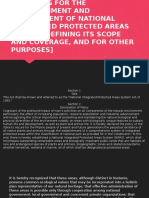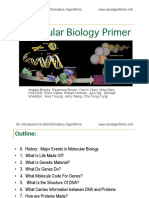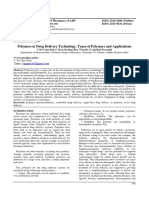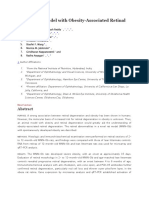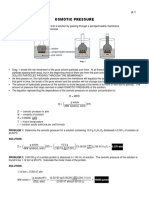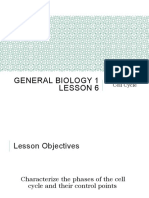Cell Division Gizmo
Uploaded by
Meg //Cell Division Gizmo
Uploaded by
Meg //Biology GIZMOS
1. Go to the Explorelearning website: https://www.explorelearning.com/
a. Put in your user/password
2. If you have not yet created an account, create one now:
a. 1st block code
b. 2nd block code
c. 3rd block code
3. Find the “Cell Division” Gizmo & click on it
Vocabulary: cell division, centriole, centromere, chromatid, chromatin, chromosome,
cytokinesis, DNA, interphase, mitosis
Prior Knowledge Questions (Do these BEFORE using the Gizmo.)
1. Cells reproduce by splitting in half, a process called cell division. What do cells need to do
between divisions to make sure that they don’t just get smaller and smaller?
They need to grow
2. The genetic information of a cell is carried in its DNA (short for deoxyribonucleic acid). What
do cells need to do between divisions to make sure that a full set of DNA gets passed on to
each daughter cell?
The DNA must be copied so there is a full set of DNA to pass on to each daughter
cell.
Gizmo Warm-up
On the SIMULATION pane of the Cell Division Gizmo, check that
the Cycle Length is set to 12 hours. Click Play ( ), observe until
the maximum number of cells is shown, and then click Pause ( ).
1. Look at the cells. Do they all look the same? Yes
2. Cells that are in the process of dividing are said to be in mitosis
or cytokinesis. Cells that are not dividing are in interphase.
Check the Magnify box and move the cursor over the cells.
A. Of the 100 cells shown, how many are in the process of dividing? 20
B. Select the BAR CHART tab, and turn on Show numerical values. How many cells
are in the interphase stage of their life cycle? 80
C. Based on these two observations, would you say that a cell spends most of its life
cycle in interphase or in mitosis/cytokinesis? Interphase
Get the Gizmo ready:
Activity A:
● Click Reset ( ).
Phases of the cell ● Select the DESCRIPTION tab.
cycle ● Click on the right arrow once so that Interphase is
shown.
Question: What are the stages of the cell cycle?
1. Observe: Click Play and hold the cursor over the cell. Observe the cell as it divides several
times. (This happens quickly!) What do you notice happening during this process?
You can see the chromosomes line up then separate and then you see two nucleuses
then the cell splits.
2. Summarize: On the DESCRIPTION pane, read about each phase in the cell cycle. In the
spaces below, sketch the cell in each phase and summarize what occurs in your own words.
Phase Sketch Summary
The cell grows and develops, developing organelles
Interphase and copying its DNA
The nuclear membrane dissolves away, the chromatin
condenses into chromosomes. Spindle fibers form
Prophase between the centrioles, which move to opposite ends
of the cell.
The spindle fibers pull the chromosomes to line them
Metaphase up on the equator.
The chromosomes are split apart by the fibers, and
Anaphase the chromatids move to opposite sides of the cell.
A nucleus forms around each of the chromosomes
Telophase and they unwind into chromatin.
The cell membrane pinches and divides the cell into
Cytokinesis two daughter cells.
(Activity A continued on next page)
Activity A (continued from previous page)
3. Analyze: Use your summaries and the Gizmo to answer the following questions:
A. What are the four phases of mitosis? Metaphase, anaphase, telophase, and
interphase
B. During which phase is the DNA duplicated? Interpahse
C. What is the relationship between chromatin and chromosomes? Chromatin is a
substance within a chromosome consisting of DNA and protein.
D. In which phase are chromatids pulled apart? Anaphase
E. What is the role of the centrioles? They have spindle fibers around them and
they help determine the ___location of the nucleus.
F. In which phase does a new nuclear membrane develop? Telophase
G. A cell has a single line of chromosomes. What is the phase? Metaphase
H. During which three phases are individual chromosomes no longer visible?
Interphase, telophase, and cytokinesis
4. RESEARCH:
A. List 3 some cells that go through the cell cycle quickly and therefore can make
new cells quickly when cells get damaged or die.
From fakered: Q1, From AS: Q1 and From CT: Q1
B. List 3 some cells that go through the cell cycle slowly and therefore can’t make
new cells quickly when cells get damaged or die.
Each step of the cell cycle is monitored by internal controls called checkpoints.
There are three major checkpoints in the cell cycle: one near the end of G1, a
second at the G2/M transition, and the third during metaphase. Positive
regulator molecules allow the cell cycle to advance to the next stage.
C. List some cells that exit the cell cycle and cannot regenerate anymore cells.
The three types of cells that cannot regenerate are hepatocytes in the live,
neurons in the brain and cardiac muscles because these cells will not under
mitosis.
You might also like
- Student Exploration: Natural Selection Gizmo56% (27)Student Exploration: Natural Selection Gizmo4 pages
- Genetic Engineering Gizmo Student Exploration Sheet50% (10)Genetic Engineering Gizmo Student Exploration Sheet7 pages
- Student Exploration: Evolution: Mutation and Selection Gizmo Answers70% (10)Student Exploration: Evolution: Mutation and Selection Gizmo Answers8 pages
- Kami Export - Gene Expression-Translation-S.161755307489% (9)Kami Export - Gene Expression-Translation-S.16175530746 pages
- DNA Profiling Gizmo Student Exploration Sheet100% (1)DNA Profiling Gizmo Student Exploration Sheet5 pages
- Gizmos - Evolution, Natural and Artificial Selection67% (9)Gizmos - Evolution, Natural and Artificial Selection9 pages
- Student Exploration: Cell Types: Vocabulary: ATP, Bacteria, Carbon Dioxide (CO44% (16)Student Exploration: Cell Types: Vocabulary: ATP, Bacteria, Carbon Dioxide (CO5 pages
- Student Exploration: Cell Energy Cycle: Gizmo Warm-UpNo ratings yetStudent Exploration: Cell Energy Cycle: Gizmo Warm-Up5 pages
- Student Exploration: Cell Division: Vocabulary: Cell Division, Centriole, Centromere, Chromatid, Chromatin, Chromosome100% (1)Student Exploration: Cell Division: Vocabulary: Cell Division, Centriole, Centromere, Chromatid, Chromatin, Chromosome7 pages
- Student Exploration: Cell Types: Vocabulary: ATP, Bacteria, Carbon Dioxide (CO0% (2)Student Exploration: Cell Types: Vocabulary: ATP, Bacteria, Carbon Dioxide (CO16 pages
- Student Exploration: Rainfall and Bird Beaks100% (1)Student Exploration: Rainfall and Bird Beaks6 pages
- Cell Division Student Exploration Doc - Alfonso Rubio-Medina100% (1)Cell Division Student Exploration Doc - Alfonso Rubio-Medina6 pages
- Biology-ModuleSixLessonThreePathwayThreeActivity Redo50% (4)Biology-ModuleSixLessonThreePathwayThreeActivity Redo7 pages
- Student Exploration: Paramecium Homeostasis67% (3)Student Exploration: Paramecium Homeostasis5 pages
- Abdallah Al Obaidi Student Genetic Mutations POGIL100% (1)Abdallah Al Obaidi Student Genetic Mutations POGIL4 pages
- 17 Ecological Relationships-S-Pogil-23natalia78% (9)17 Ecological Relationships-S-Pogil-23natalia13 pages
- PDF Neurodegeneration Methods and Protocols Methods in Molecular Biology v793 2011th Edition Giovanni Manfredi Download100% (13)PDF Neurodegeneration Methods and Protocols Methods in Molecular Biology v793 2011th Edition Giovanni Manfredi Download60 pages
- (Ebook) Amyloid Proteins: Methods and Protocols by Einar M. Sigurdsson, Miguel Calero, María Gasset ISBN 9781617795503, 161779550X download100% (3)(Ebook) Amyloid Proteins: Methods and Protocols by Einar M. Sigurdsson, Miguel Calero, María Gasset ISBN 9781617795503, 161779550X download49 pages
- Isolation and Characterization of Collagen From Chicken FeetNo ratings yetIsolation and Characterization of Collagen From Chicken Feet5 pages
- Biologia Molecular - An Introduction To Bioinformatics AlgorithmsNo ratings yetBiologia Molecular - An Introduction To Bioinformatics Algorithms271 pages
- TNPSC Group 2/2A Mains Orientation Class: General StudiesNo ratings yetTNPSC Group 2/2A Mains Orientation Class: General Studies8 pages
- Polymers in Drug Delivery Technology, Types of Polymers and ApplicationsNo ratings yetPolymers in Drug Delivery Technology, Types of Polymers and Applications4 pages
- Lexical Cloze Genetic Engineering For AthletesNo ratings yetLexical Cloze Genetic Engineering For Athletes2 pages
- UACE Biology 2020 Paper 2 With Answers 1No ratings yetUACE Biology 2020 Paper 2 With Answers 110 pages
- Day-17 - Pedigree Analysis Test Paper - FinalNo ratings yetDay-17 - Pedigree Analysis Test Paper - Final2 pages
- Genetic Engineering Gizmo Student Exploration SheetGenetic Engineering Gizmo Student Exploration Sheet
- Student Exploration: Evolution: Mutation and Selection Gizmo AnswersStudent Exploration: Evolution: Mutation and Selection Gizmo Answers
- Kami Export - Gene Expression-Translation-S.1617553074Kami Export - Gene Expression-Translation-S.1617553074
- Gizmos - Evolution, Natural and Artificial SelectionGizmos - Evolution, Natural and Artificial Selection
- Student Exploration: Cell Types: Vocabulary: ATP, Bacteria, Carbon Dioxide (COStudent Exploration: Cell Types: Vocabulary: ATP, Bacteria, Carbon Dioxide (CO
- Student Exploration: Cell Energy Cycle: Gizmo Warm-UpStudent Exploration: Cell Energy Cycle: Gizmo Warm-Up
- Student Exploration: Cell Division: Vocabulary: Cell Division, Centriole, Centromere, Chromatid, Chromatin, ChromosomeStudent Exploration: Cell Division: Vocabulary: Cell Division, Centriole, Centromere, Chromatid, Chromatin, Chromosome
- Student Exploration: Cell Types: Vocabulary: ATP, Bacteria, Carbon Dioxide (COStudent Exploration: Cell Types: Vocabulary: ATP, Bacteria, Carbon Dioxide (CO
- Cell Division Student Exploration Doc - Alfonso Rubio-MedinaCell Division Student Exploration Doc - Alfonso Rubio-Medina
- Biology-ModuleSixLessonThreePathwayThreeActivity RedoBiology-ModuleSixLessonThreePathwayThreeActivity Redo
- Abdallah Al Obaidi Student Genetic Mutations POGILAbdallah Al Obaidi Student Genetic Mutations POGIL
- PDF Neurodegeneration Methods and Protocols Methods in Molecular Biology v793 2011th Edition Giovanni Manfredi DownloadPDF Neurodegeneration Methods and Protocols Methods in Molecular Biology v793 2011th Edition Giovanni Manfredi Download
- (Ebook) Amyloid Proteins: Methods and Protocols by Einar M. Sigurdsson, Miguel Calero, María Gasset ISBN 9781617795503, 161779550X download(Ebook) Amyloid Proteins: Methods and Protocols by Einar M. Sigurdsson, Miguel Calero, María Gasset ISBN 9781617795503, 161779550X download
- Isolation and Characterization of Collagen From Chicken FeetIsolation and Characterization of Collagen From Chicken Feet
- Biologia Molecular - An Introduction To Bioinformatics AlgorithmsBiologia Molecular - An Introduction To Bioinformatics Algorithms
- TNPSC Group 2/2A Mains Orientation Class: General StudiesTNPSC Group 2/2A Mains Orientation Class: General Studies
- Polymers in Drug Delivery Technology, Types of Polymers and ApplicationsPolymers in Drug Delivery Technology, Types of Polymers and Applications




































